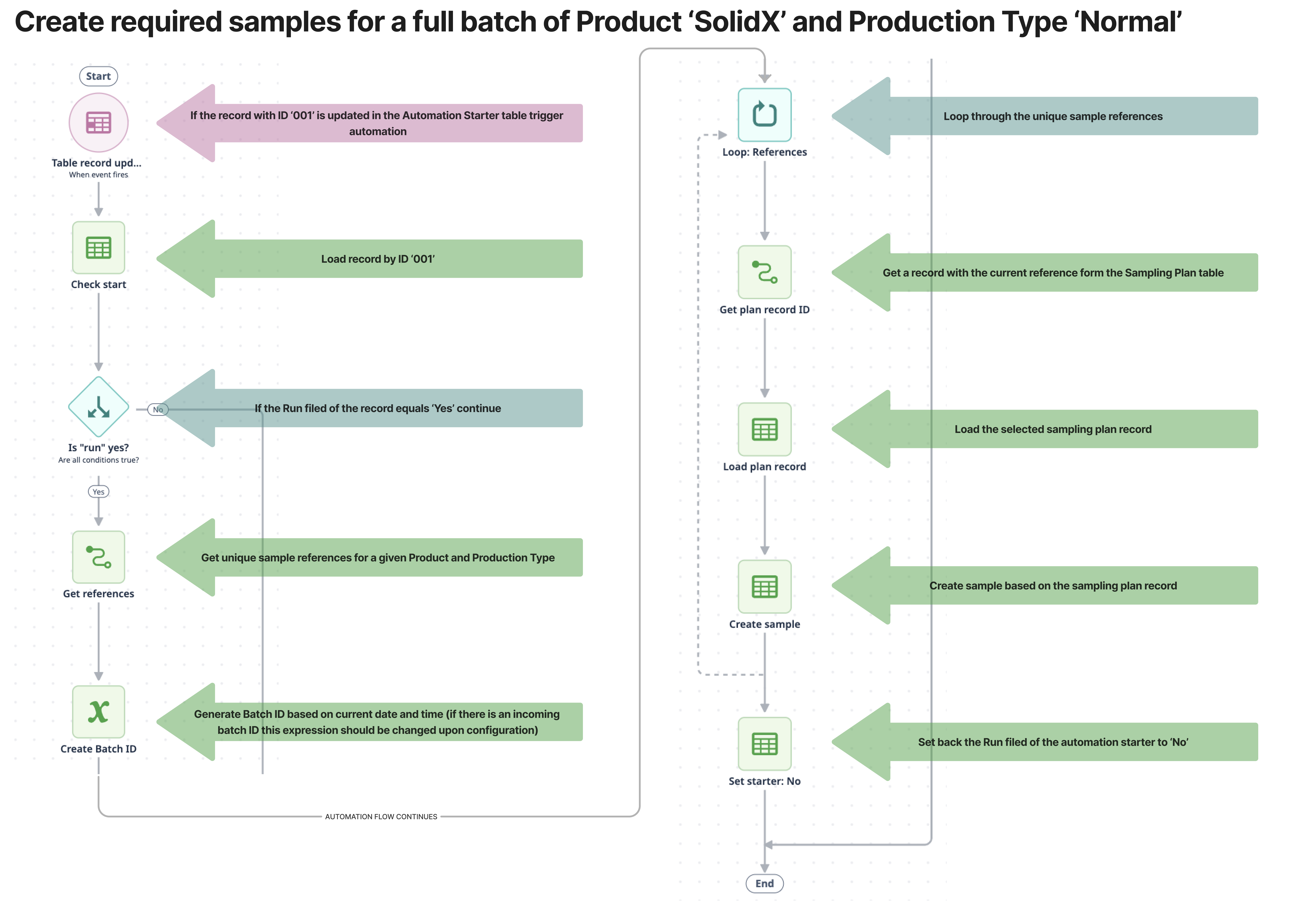실험실 관리 앱 그룹에서 시료 관리를 위한 두 가지 옵션을 소개합니다.
제품(예: 고분자, 제약, 혈액), 실험실 유형(예: QC 실험실, R&D 실험실, 생명공학 실험실), 디지털화 수준에 따라 시료 수령 및 관리에 적합한 전략이 다를 수 있습니다. Tulip의 실험실 관리 앱 그룹에서는 수동 샘플 수령 및 작업 할당에 기반한 옵션과 샘플링 계획에 따른 자동 수령 및 할당에 기반한 옵션의 두 가지 주요 옵션을 제공합니다. 이 문서에서는 두 가지 전략 중 하나를 선택하기 위한 가이드라인을 제공한 다음 두 가지 전략에 대해 자세히 설명합니다.
:::(Info) If you'd like to learn more about the app suite, visit the Laboratory Management article
:::
어떤 옵션을 선택해야 하나요?
두 가지 전략('옵션 A'와 '옵션 B')의 주요 차이점은 샘플링 계획의 사용 여부입니다.
유연한 작업 할당이 가능한 옵션 A는 샘플링 계획 표를 사용하지 않습니다. 샘플을 받으면 앱 사용자가 샘플 세부 정보를 수동으로 입력하면 목록에서 샘플 절차가 선택되어 샘플에 할당됩니다.
반면, 옵션 B는 샘플링 계획 테이블, Tulip API 커넥터 및 자동화를 활용하여 샘플 관리 프로세스를 간소화하고 표준화합니다. 생산 배치에서 채취할 샘플 목록과 필요한 샘플 절차는 샘플링 계획 테이블에 저장되며, Tulip Automation을 사용하여 실험실 운영 시스템에 자동으로 통합됩니다.
:::(Info)Tulip API Connectors
:::
옵션 A: 샘플링 계획 미사용
- 유연한 작업 할당: 모든 샘플 유형에 대해 샘플 절차의 조합을 선택하고 샘플에 할당합니다.
- 샘플 세부 정보를 수동으로 입력하여 샘플 수령 가능
- 제약용 컴포저블 MES와 호환(링크)
- 점진적 도입: 샘플링 계획 없이 사용 가능하며 나중에 샘플링 계획과 함께 업그레이드 가능
옵션 B: 샘플링 계획 사용
- 단 한 번의 클릭으로 샘플 수령
- 샘플 계획을 관리하고 샘플 수령 시 참조 데이터로 사용
- 자동화를 활용하여 사용자 경험 간소화
- 실험실에서 표준 운영 프로세스 사용
옵션 A에 대한 자세한 설명: 유연한 작업 할당
- 샘플 세부 정보를 입력합니다: 사용자는 샘플 수령의 첫 번째 단계로 샘플 세부 정보를 입력해야 합니다. 세부 정보는 샘플 접수 문서에서 전송되며 탐색 시 샘플이 샘플 테이블에 추가됩니다. 샘플이 Tulip 기반 시스템에서 수집되어 이미 샘플 테이블에 있는 경우에는 이 단계를 건너뛸 수 있습니다.

- 샘플이 샘플 데이터베이스에 추가되면 실제 공간에서도 샘플을 식별해야 합니다. 샘플 수명 주기 동안 언제든지 바코드 스캐너로 샘플을 식별할 수 있도록 각 샘플에 바코드가 인쇄되어 있습니다(예: 샘플을 보관소에 넣거나 뺄 때, 샘플 절차를 실행할 때). 바코드 스캐너를 구성할 때 이 단계에 바코드 스캐너와의 통합을 추가해야 합니다. 샘플이 Tulip 기반 시스템에서 채취되어 이미 샘플 테이블에 있고 샘플에 레이블이 지정된 경우 이 단계를 건너뛸 수 있습니다.


- 새로 받은 샘플의 저장 위치를 스캔하고 샘플 테이블에 위치 ID를 저장합니다

- 단일 선택 위젯에서 프로시저를 하나씩 선택하여 샘플에 추가합니다. 프로시저를 추가하면 프로시저의 이름과 샘플 ID가 Target 참조로 저장된 레코드가 작업 테이블에 생성됩니다. 추가된 프로시저는 대화형 테이블 위젯에서 볼 수 있습니다. 필요한 모든 프로시저가 추가되면 샘플 수신 프로세스가 완료되고 사용자는 기본 화면으로 돌아갈 수 있습니다.

옵션 B에 대한 자세한 설명: 샘플링 계획 사용
- 특정 제품, 생산 유형 및 배치 ID의 배치가 생산되고 있다는 정보는 '전체 배치에 필요한 샘플 생성'이라는 첫 번째 자동화를 트리거해야 합니다. 이 애플리케이션과 자동화가 라이브러리에서 다운로드되었다고 가정해 보겠습니다. 이 경우 분홍색 시뮬레이션 버튼은 자동화 시작 테이블의 레코드를 ID '001'로 업데이트하고, 특히 실행 필드의 값을 '예'로 설정하여 자동화를 트리거합니다. 그 후 자동화는 제품 'SolidX' 및 생산 유형 '일반'의 샘플링 계획에서 모든 샘플을 샘플 테이블로 가져와 '필요' 상태를 부여합니다. 여러 계획의 경우 자동화를 복제하고 매개 변수를 고유한 제품 이름 및 생산 유형으로 변경합니다. 자동화 작동 방식에 대한 자세한 내용은 아래의 '제품 'SolidX' 및 생산 유형 '일반'의 전체 배치에 필요한 샘플 생성' 다이어그램을 참조하세요.
제품 'SolidX' 및 생산 유형 '일반' 자동화의 전체 배치에 필요한 샘플 생성하기


- 샘플 수령의 두 번째 단계로, 사용자는 필요한 샘플을 선택하고 향후 식별을 위해 라벨을 인쇄해야 합니다. 라벨을 인쇄하면 샘플의 상태가 '수신됨'이 되고 다음 자동화인 '샘플링 계획에서 작업으로 샘플 절차 가져오기'가 트리거됩니다. 이 자동화는 샘플링 계획을 참조로 삼아 지정된 샘플 유형을 찾은 다음 샘플링 계획에서 필요한 모든 샘플 절차를 가져오고 작업 테이블의 보류 중인 샘플 절차를 가져옵니다. 자동화의 작동 방식에 대한 자세한 내용은 아래의 '샘플링 계획에서 작업으로 샘플 절차 가져오기' 다이어그램을 참조하세요.

- 라이브러리에서 계획으로 샘플 관리 앱을 다운로드하고 필요한 자동화: '샘플링 계획에서 작업으로 샘플 절차 가져오기' 단계는 작업 테이블이 채워지는 방법을 보여줍니다. 이 단계는 작업 목록을 보는 것이 앱 사용자의 관심사가 아닌 경우 삭제할 수 있습니다.

- 샘플 수신 흐름의 마지막 단계로 새로 받은 샘플의 저장 위치를 스캔하고 위치 ID를 샘플 테이블에 저장합니다

